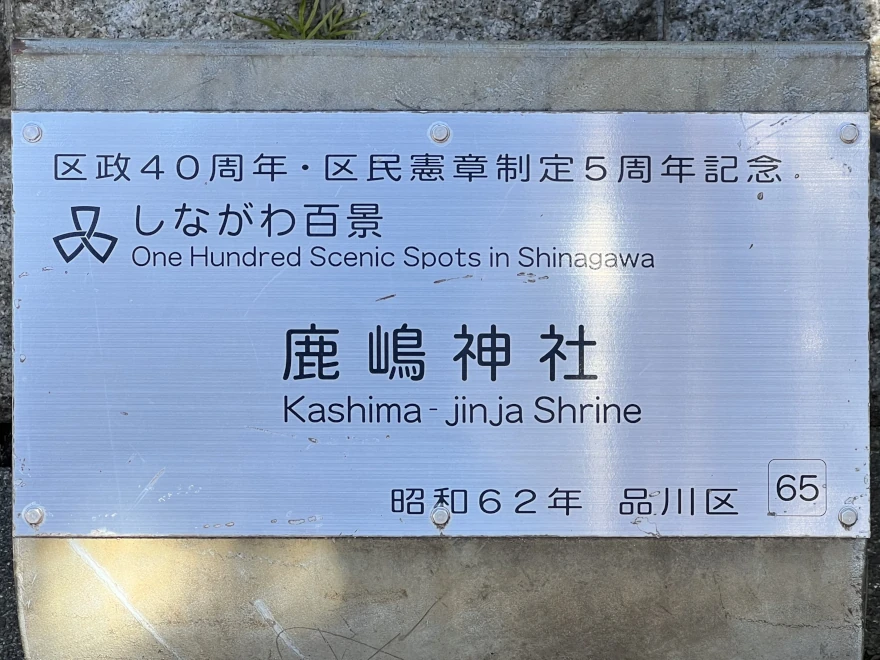⛩ Kashima Shrine – Guardian of Victory, Safety, and Tradition
Situated in the heart of Ōi, Kashima Shrine (鹿嶋神社) has served for over a thousand years as a place of prayer, protection, and prosperity. It is dedicated to Takemikazuchi-no-Ōkami, a thunder god and divine warrior who played a central role in the mythological pacification of Japan. As a branch of the famous Kashima Jingū in Ibaraki, this shrine was established in 969 CE during the reign of Emperor Reizei.
According to tradition, a monk named Son’ei from Shingon-affiliated Jōgyō-ji Temple in Minami-Shinagawa brought the deity’s spirit to Ōi and founded the shrine. The surrounding valley came to be known as “Kashima-dani,” and the shrine became the spiritual heart of the community. Alongside it, a now-vanished temple called Raigō-in was built as its bettōji (managing temple) until the Meiji-era separation of Buddhism and Shinto.
From the Heian period through the Edo era and into modern times, the shrine has stood as a guardian for safe travel, successful journeys, victory in battle, and good fortune in commerce. The phrase “Kashima-dachi” (鹿嶋立ち)—meaning to depart on a journey with divine protection—is rooted in this tradition. Warriors heading to the frontier would often pray here for safety and success before setting out.
Today, Kashima Shrine preserves a wide array of cultural assets. The main hall (honden), built in 1931, is an elegant example of traditional nagare-zukuri architecture with unpainted cypress wood and detailed metalwork. The earlier 1811 hall, notable for its Kamakura-style carvings, now stands nearby and enshrines the deities of five merged sub-shrines: Tenjin, Konpira, Inari, Mitsumine, and Hachiman.
The precincts also include:
- Tabunoki Trees: two remarkable camphor-like trees (タブノキ, also known as Inugusu), both designated as Natural Monuments by Shinagawa Ward on February 14, 1978. These evergreen trees, native to Japan’s warmer coastal regions, are rare survivors in urban Tokyo and especially precious in the Ōi area. The first tree, located to the left of the worship hall, has a trunk circumference of 3.1 meters and originally stood over 20 meters tall. Although the upper half was lost in a strong windstorm in 1977, the remaining structure—with its broad-reaching lower branches and reinforced top—still presents a majestic sight. The second tree stands 18 meters tall with a 2.5-meter girth and is positioned in front of the relocated former main shrine building. It remains healthy and stately, a vivid example of preserved natural beauty in the city. These trees are emblematic of the historical and botanical significance embedded within the shrine precincts.
- Japanese Red Oak Tree: Behind the relocated former main hall of Kashima Shrine stands a rare and resilient Akagashi (アカガシ, or Japanese Red Oak), also designated a Natural Monument by Shinagawa Ward in 1978. Estimated to be around 200 years old, the tree now rises to 6 meters in height with a trunk circumference of 2.1 meters. Though its upper half was lost to storm damage and is now capped with a protective metal plate, the tree has shown signs of vigorous recovery—sprouting new leaves and lower branches after a period of dormancy. As a species of evergreen oak native to Japan’s warmer regions, Akagashi is especially rare in Tokyo and typically survives only in the protected grounds of shrines and temples.
- 1780s Stone Torii and Komainu: The stone torii gate and the flanking komainu guardian statues date to the late Edo period (ca. 1780s). These retain their original stonework and exhibit stylistic details typical of the period.
- Furōmon Monument: This stone stele inscribed with “不老門” (“Gate of Immortality”) is said to grant blessings of long life to those who pass through or pray before it. It is a beloved local feature, frequently adorned with offerings and seasonal flowers.
- Chikara-ishi (力石): Two large “strength stones” rest near the approach path. Traditionally, young men would test their strength by lifting them during the shrine’s festival. They are still displayed with carved weights and inscriptions as cultural relics.
- Haiku Monument by Ono Keizan (小野敬山句碑): Another stone monument within the shrine grounds bears a haiku poem by Ono Keizan, a haiku poet and the headman of Ōi Village. This monument honors his literary contributions and his role in the local community. The haiku inscribed reflects the cultural and poetic heritage of the area.
- Ōi Bayashi Festival Music: The vibrant Ōi Hayashi festival music, designated as Shinagawa Ward’s first Intangible Folk Cultural Property in 1985, has its roots in Edo-period traditions. Originating in 1820 under the leadership of a local farmer named Kuramoto Hikogorō, the ensemble features a classic five-part structure: large drum, small drums, gong, and flute. Though it declined briefly after WWII, it was revived in 1961 and is now performed during the summer and autumn festivals of Kashima Shrine. The tradition remains alive today through a multigenerational preservation society.
Every October, the shrine hosts a major autumn festival filled with music, processions, and community rituals. From ancient roots to contemporary devotion, Kashima Shrine continues to be a source of spiritual grounding and local pride.
🌀 Shrine Details
- Deity: Takemikazuchi-no-Ōkami
- Affiliation: Branch of Kashima Jingū (Ibaraki)
- Founded: 969 CE (Anwa 2)
- Annual Events: Grand Autumn Festival (mid-October), Setsubun, Shichi-Go-San ceremonies
- Special Features: Kamakura carvings, historic torii, Oi Hayashi music, longevity monuments
📍 Visitor Information
Address: 6-18-36 Ōi, Shinagawa-ku, Tokyo 140-0014
Opening Hours: 9:00 AM – 5:00 PM daily
Phone: 03-3775-0753
Official Info: kashimajinja.wixsite.com/omatsuri
Note: Please maintain quiet and respect when visiting. This is an active site of worship for many local residents.
Where is it?
| what3words | ///already.fairly.pirate |
| latitude longitude | 35.59567, 139.727975 |
| Nearest station(s) | Tachiaigawa Station (Keikyu line) Ōmori Station (Keihin Tohoku Line and Tokaido Main Line) Ōimachi Station (Rinkai, Oimachi, Keihin Tohoku Line and Tokaido Main Line) |
| Nearest public conveniences | Nearby Shinagawa History Museum or convenience stores |
Show me a sign.

The Hyakkei sign is just beside the main gate.
Withervee says…
Tranquil, leafy, and mostly unvisited by tourists — just how I like my shrines. Ideal for taking a contemplative breather between museum stops.
Site Character
- Lifestyle 生活 (Seikatsu): ✔️
- Historical Significance 歴史 (Rekishi): ✔️
- Atmosphere/Natural Features 風土 (Fūdo): ✔️
Who in their right mind would vote for this?
- Traditionalists
- Shinto pilgrims
- Quiet souls
- History fans
- Local walkers
Further reading
Tokyo Metropolitan Shrine Association – Kashima Jinja
While you’re there…
Combine this with a visit to the Shinagawa Historical Museum just 5 minutes away. Great double-bill for a historical stroll.
Footnote(s):
1. Anwa 2 (安和二年) refers to the second year of the Anwa era, equivalent to 969 CE in the Gregorian calendar.
2. 分霊 (bunrei) means “divided spirit” — a Shinto practice in which part of a kami’s spirit is transferred to a new shrine, enabling it to share in the original shrine’s sanctity.

